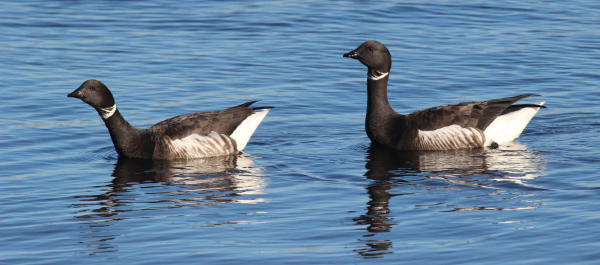
Brant
|
When I’m stuck in traffic, I sometimes fantasize about how I’d spend the lottery jackpot. It usually comes down to land; for birds. Lots and lots of land for birds.
Woodlands spiked with dogwoods would lure Scarlet Tanagers. Prairies full of native grasses would draw Henslow’s Sparrows and Upland Sandpipers. Vast swamps for nesting Swallow-tailed Kites and Swainson’s Warblers. Just about the time I’m investing in tidal marshes for Seaside Sparrows, though, somebody toots their horn and reminds me that it’s time to pull forward. Reality sets in, I’m still in traffic and I don’t have the winning lottery ticket.
I may never have lottery winnings to invest in bird habitat, but buying a Duck Stamp each year may be the next best thing on another scale. All birders should buy an annual Duck Stamp for $25; in turn, enlightened conservationists find and purchase the highest quality habitats in the country for waterfowl and all birds and other wildlife. In most cases, the protected habitat is open to the public as part of the National Wildlife Refuge System.
The Duck Stamp, formally known as the Federal Migratory Bird Hunting and Conservation Stamp, was created in 1934 to encourage waterfowl hunters to help conserve wetlands. Duck Stamps are pure magic for birds and every birder should buy one every year.
More than 98 cents of every dollar raised through the Duck Stamp Program goes directly to land conservation. Since 1934, more than $1 billion has been generated and more than 5.7 million acres of habitat has been permanently protected at more than 300 national wildlife refuges.
Waterfowl are not the only beneficiaries of the Duck Stamp Program. The connection between the birds in your backyard and the lands protected through the Duck Stamp Program is simple and direct: Birds need habitat throughout their migration routes and on their wintering range. You can extend your yard by thousands of miles just by buying the stamp.
Take Ruby-throated Hummingbirds, for example. During summer, our South Carolina backyard is like Chicago’s O’Hare Airport on Mondaymorning, but more chaotic because our hummers seem to have no flight plans. They dive bomb each other, our dogs, us, and then each other again.
When they leave our yard, they begin a perilous journey that likely includes a flight across the expansive Gulf of Mexico into Mexico or Central America. By purchasing a Duck Stamp, we can help provide sanctuary along the way. Duck Stamp dollars helped add nearly 47,000 acres to San Bernard National Wildlife Refuge in Texas, a prime resting and feeding area for neotropical migratory birds such as Ruby-throated Hummingbirds.
A floodplain forest near our house attracts American Woodcocks during migration. More than likely, these woodcocks nested in the northeastern United States. My purchase really pays off there, because stamp revenue has helped acquire nearly 20,000 acres at Maine’s Moosehorn National Wildlife Refuge, where alder thickets provide prime woodcock habitat.
My friend Donn Waage enjoys reporting the waterfowl he spots at his weekend retreat property in Minnesota. Donn’s Duck Stamp purchase contributes to dozens of refuges scattered along the Mississippi Flyway, such as in Arkansas, where stamp proceeds helped to purchase 50,000 acres for the Cache River National Wildlife Refuge, where Wood Ducks and other waterfowl are abundant.
Duck Stamp dollars help protect a string of national wildlife refuges that conserve rapidly disappearing natural habitats on the Pacific Coast. California’s Humboldt Bay National Wildlife Refuge, for example, may host upwards of 100,000 waterfowl that flock there to feed among the extensive eelgrass beds and tidal mudflats. This refuge provides critical habitat for wintering sea geese – Brant – in particular.
Keep your Duck Stamp handy in the field – it grants free entrance to the national wildlife refuges that charge a fee. Most U.S. Post Offices sell Duck Stamps, as do most sporting goods stores. You can even order Duck Stamps from the American Birding Association.
It’s important to buy the stamp and even more important to let other birders know that you bought one, and why. I display mine in a plastic holder that dangles from my binocular, a system developed by the Georgia Ornithological Society to help birders demonstrate their commitment to the stamp. Duck Stamps also make great gifts!
Article by Peter Stangel
For information about the Duck Stamp program including purchasing details, see https://www.fws.gov/birds/get-involved/duck-stamp.php